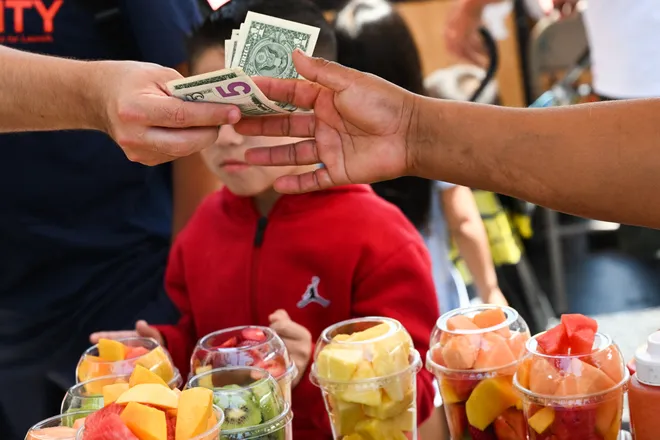Inflation slowed again, new CPI report shows: Will the Fed keep cutting rates?
Inflation hit a fresh three-year low in September as another drop in gasoline prices offset a rise in used car and auto insurance costs. But price gains slowed less than expected and a gauge of underlying price increases picked up.
Overall consumer prices increased 2.4% from a year ago, down from 2.5% in August, according to the Labor Department’s consumer price index, a wide-ranging gauge of goods and services costs. That’s the smallest increase since February 2021 and the sixth straight pullback, leaving inflation modestly above the Fed’s 2% goal. Economists polled by Bloomberg, though, expected a drop to 2.3%.
On a monthly basis, costs edged up 0.2%, in line with the previous month.
The latest pullback likely should still keep the Federal Reserve on track to lower interest rates by a more measured quarter percentage point next month after its initial half-point reduction in September juiced the stock market.
What is the core inflation rate today?
Core inflation, which excludes volatile food and energy items and is watched more closely by the Fed, increased 0.3%, similar to August. That nudged up yearly core inflation to 3.3% from 3.2% the month before. Forecasters expected the core measure to hold steady.
Capitalize on high interest rates: Best current CD rates
Food and energy prices are often more volatile because they respond to the sharp price swings of global commodities such as oil and wheat. The Fed prefers to focus on more sustained price changes that reflect consumer and business demand and can be affected by interest rates.

What is the Fed interest rate today?
After slashing a key interest rate by a half point in September, Fed officials signaled they’ll probably lower it by a quarter point at each of their final two meetings this year as long as inflation continues to soften. That would reduce the rate from about 4.8% to about 4.3%.
With inflation seemingly headed toward the Fed’s 2% target, it likely would take an unusually weak, or strong, labor market to alter officials’ blueprint for quarter-point rate cuts, Bank of America wrote in a note to clients. U.S. employers unexpectedly added a booming 254,000 jobs in September, calming fears of substantially weakening employment growth and a possible recession.
Thursday's slightly hotter-than-expected inflation report probably keeps the Fed on course to reduce rates by a quarter percentage point next month, some economists said, but it virtually rules out another half-point cut. And if job growth surges again in October, the Fed may have to considering pausing, some forecasters suggested.
"This is not what the Fed wanted to see after its bold move in September and virtually rules out another large cut in November," economist Sal Guatieri wrote in a note to clients. "While we still lean toward a quarter-point reduction, much will depend on whether we see a second straight strong jobs report in October."
From March 2022 to July 2023, the Fed raised its benchmark short-term rate from near zero to a 23-year high of 5% to 5.25% to help wrestle down inflation.
Spend your money smart: Sign up for USA TODAY's Daily Money newsletter.
Why are gas prices dropping in the US?
Gasoline prices fell 4.1% in September and have declined or flatlined for four of the past five months amid slowing global growth and record U.S. oil production that have dampened crude oil prices. Regular unleaded averaged $3.20 a gallon Wednesday, down from $3.27 last month and $3.70 a year ago.
Are rents falling in the US?
Rent increased 0.3% in September after rising 0.4% the previous month. That pushed down the annual increase from 5% to 4.8%, the lowest since April 2022. Lower rents for new leases are finally starting to filter through to rates for existing tenants.
That’s good news because housing costs broadly have been the biggest factor driving inflation and accounted for 36% of the rise in prices last month.
Some other services costs also climbed higher and contributed to the pickup in core inflation. Auto insurance rates increased 1.2% and are up 16.3% the past year. Car repair costs jumped 1%. Medical care services climbed 0.7%. And airline fares increased 3.2% after a 3.9% rise the previous month. Hotel rates, tough, dipped 1.9%.
Meanwhile, some goods prices that had been softening rose last month. Used car prices increased 0.3%; apparel, 1.1%; and furniture, 1.7%.
Are food prices expected to drop?
Grocery prices jumped 0.4% after a string of flat or trivial increases.
Last month, the cost of eggs surged 8.4% amid a two-year bird flu outbreak. Bacon costs rose 1.6%, uncooked ground beef increased 0.4%, and chicken edged up 0.2%.
Modestly offsetting the more expensive proteins were a 0.4% price drop for breakfast cereal and a 0.2% dip for bread.
Restaurant prices, meanwhile, have continued to advance because of higher labor costs, rising 0.3% for the second straight month.
(This story was updated to add new information.)
Disclaimer: The copyright of this article belongs to the original author. Reposting this article is solely for the purpose of information dissemination and does not constitute any investment advice. If there is any infringement, please contact us immediately. We will make corrections or deletions as necessary. Thank you.







